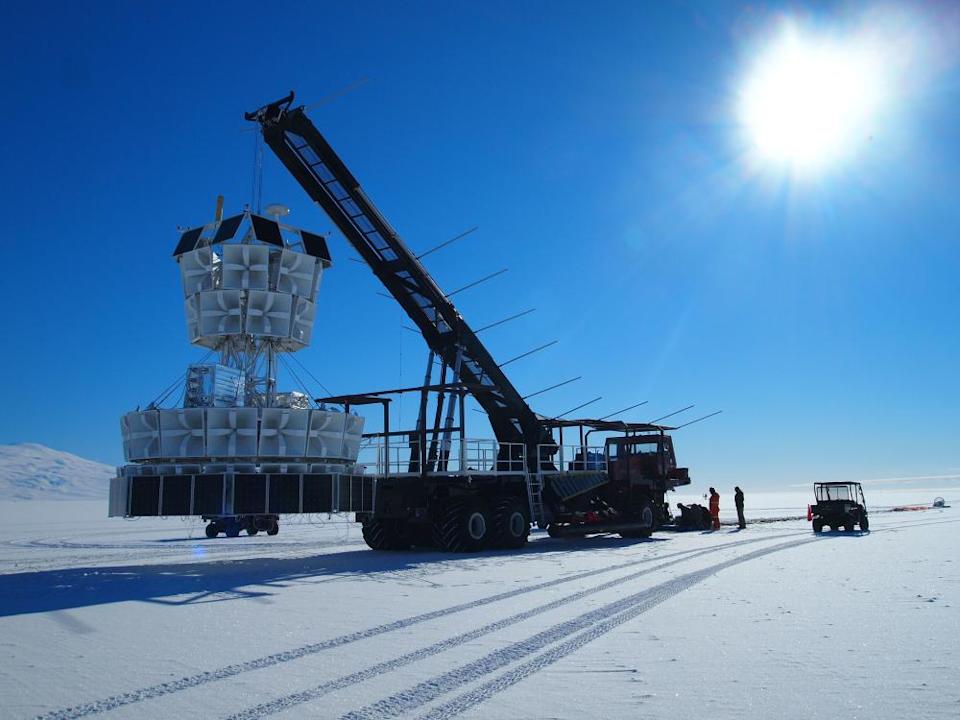Mysterious Radio Pulses from Antarctica: A Clue to New Particle Discovery?
An illustration shows a strange signal on the horizon of Antarctica, captured by a cosmic particle detector. The results of this experiment, conducted by the Antarctic Impulsive Transient Antenna (ANITA) experiment, have left scientists puzzled as the signals defy current explanations in particle physics.

The ANITA experiment, which floats over Antarctica using balloons to detect ultra-high-energy cosmic neutrinos and other cosmic rays, usually picks up signals reflected off the ice. However, these latest signals came from below the horizon at an orientation that cannot be explained by current particle physics models.
"It's an interesting problem, because we still don't actually have an explanation for what those anomalies are," said Stephanie Wissel, a member of the ANITA team and researcher at Penn State University. "What we do know is that they're most likely not representing neutrinos."
The radio waves detected by ANITA were oriented at very steep angles, 30 degrees below the surface of the ice. This means that the signal had to pass through thousands of miles of rock before reaching ANITA, which should have led to interactions that made the radio pulses too faint to be detectable. However, this did not happen in this case.
The immediate suspect for this signal is neutrinos, which are known as "ghost particles" due to their lack of charge and virtually massless nature. Neutrinos stream through the cosmos at near-light speeds after being launched by powerful cosmic events and can "phase" through matter, barely interacting. This makes them incredible "messengers" that can teach scientists about the events that launched them. However, their ghostly nature also makes them incredibly tough to detect.
Fortunately, even catching one neutrino as it passes through Earth can reveal a wealth of information. Designing sophisticated experiments and taking them to remote regions of Earth or placing them deep underground in the hope of detecting a cosmic ghost is well worth the effort for scientists like Wissel.

ANITA floats 25 miles over the ice of Antarctica, away from the possibility of other interfering signals, hunting for so-called "ice showers" caused by tau neutrinos striking the ice and interacting to create a daughter particle called a tau lepton. This rapidly decays into an "air shower" containing even smaller constituent particles.
However, because the angle of these newly detected signals is sharper than current models of physics allow, the backtracking process isn't possible in this case. Even more confusingly, other neutrino detectors like the IceCube Experiment and the Pierre Auger Observatory didn't detect anything that could explain these signals and the upward-oriented air shower.
Thus, the ANITA researchers have declared the signals as "anomalous," determining they weren't the result of neutrinos. The signals could therefore be indicative of something new, perhaps even a hint of dark matter, the mysterious cosmic "stuff" that accounts for around 85% of the universe's matter content.
Related Stories:
- Scientists detect highest-energy ghost particle ever seen — where did it come from?
The discovery of mysterious radio pulses emanating from Antarctica could be a smoking gun pointing towards the existence and investigation of new particle physics phenomena, igniting renewed hope for breakthroughs in fundamental science.
The detection of mysterious radio pulses emanating from Antarctica holds the promise not only to unravel cosmic mysteries but potentially unveil new frontiers in particle physics – a thrilling prospect for scientific discovery.
These elusive radio pulses detected from Antarctica hint at the potential discovery of new fundamental particles, igniting a fresh chapter in physics' quest for understanding our cosmos.
The discovery of mysterious radio pulses emanating from Antarctica might hold a key insight into the mysteries surrounding new particle physics, suggesting intriguing possibilities for advancing our understanding beyond current limits.
The discovery of mysterious radio pulses emanating from Antarctica could be a striking lead towards the unveiling new particle physics, tantalizing physicists worldwide eager to unlock yet-unseen forces in our universe.
The mysterious radio pulses emanating from Antarctica investigated in this study could harbor a crucial clue to the discovery of new subatomic particles, shedding light on uncharted realms within our cosmos.
The Mysterious Radio Pulses emanating from Antarctica could be a pivotal clue in the quest for new particleurrencies, setting off an avalanche of theoretical research and experimental verification across physics domains.
Fascinating speculation! The detection of mysterious radio pulses from Antarctica might indeed serve as an enigmatic clue, directing us towards the discovery and understanding of new subatomic particles.
Recent discovery of mysterious radio pulses emanating from Antarctica could be a cherished clue revealing the existence of unknown particles, stimulating fresh frontiers in particle physics.
The detection of mysterious radio pulses emanating from Antarctica may represent a pivotal breakthrough in our understanding, hinting at the discovery of novel particles that could reshape physics as we know it.
The recent discovery of mysterious radio pulses originating from Antarctica may hold the key to a new frontier in particle physics, hinting at previously unknown fundamental forces.
The discovery of mysterious radio pulses from Antarctica presents not just a clue but an intriguing portal towards the exploration and understanding suitable conditions for new particle physics, potentially reshaping our comprehension in under-explored realms.
These mysterious radio pulses detected in Antarctica hold the potential of shedding light on a previously unidentified particle, signifying profound implications for our understanding and expansion into exotic physics frontiers.
The mysterious radio pulses detected from Antarctica raise intriguing questions about our understanding of the nature at its deepest layer. These findings could potentially lead to a breakthrough in discovering novel fundamental particles, sparking new avenues for subatomic physics research.
The mysterious radio pulses originating from Antarctica could potentially lead to a breakthrough in the discovery of new fundamental particles, further expanding our understanding of cosmic mysteries and physics beyond current theories.














